The Russian navy's biggest warships are becoming its biggest headaches
Russia's navy has had limited involvement in the war in Ukraine.
But the war may be affecting Russia's plans to modernize and upgrade its navy.
Ongoing problems with the Russian navy's biggest warships illustrate that trend.
Russia's navy has limited involvement in Ukraine, but like the rest of Russia's military, it is still feeling the effects of the war.
Ukraine has sunk a handful of Russian naval ships but the only major one has been the guided-missile cruiser Moskva — an embarrassing loss because it was the Black Sea Fleet's flagship. Away from the battlefield, however, Moscow's setbacks in Ukraine appear to be affecting its naval modernization plans.
This seems most evident with Russia's largest surface warships: its Kirov-class nuclear-powered battlecruisers, Admiral Nakhimov and Pyotr Velikiy, and the Admiral Kuznetsov, Russia's sole aircraft carrier.
They should be the most capable vessels in Russia's surface fleet, but a combination of maintenance issues, funding woes, and poor operational records has made them the Russian navy's biggest headaches.
Kirovs and Kuznetsov
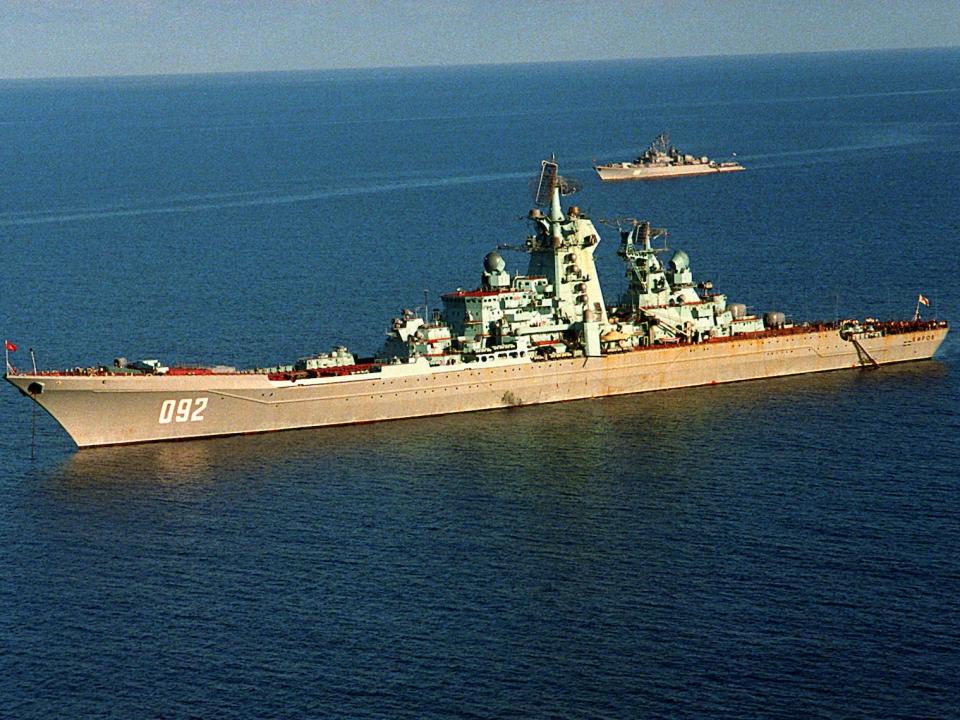
The Kirov-class battlecruisers emerged from a mid-1960s Soviet project to create nuclear-powered warships capable of destroying the nuclear-powered ballistic-missile submarines in service with NATO navies.
Known in Russia as the Project 1144 Orlan class, the design was eventually merged with a competing cruiser project. Construction began on the first ship, called Kirov, in 1974. By the time it was commissioned in 1980, Kirov-class battlecruisers were meant to able to take on every type of enemy vessel.
Only four of five planned vessels were actually built. The first three — Kirov, Frunze, and Kalinin — entered service in 1980, 1984, and 1988, respectively. The fourth, Pyotr Velikiy, was commissioned into Russia's navy in 1998.
At 827 feet long and with a full displacement of 28,000 tons, Kirov-class battlecruisers are the largest surface warships in the world other than aircraft carriers. Each ship has two nuclear reactors, giving them a range limited only by the endurance of their crews and their machinery.

The Kirovs are also perhaps the most heavily armed warships ever. Pyotr Velikiy, the only ship still in active service, has a main armament of 20 P-700 Granit anti-ship cruise missiles, each of which can carry a 1,653-pound warhead (or a nuclear warhead), has a range of 388 miles, and a top speed of Mach 2.5.
For air defense, Pyotr Velikiy carries 72 S-300 surface-to-air missiles, 128 3K95 Kinzhal SAMs, and six 3M87 Kortik close-in weapon systems, each of which is armed with eight 9M311 SAMs. To defend against submarines, it has one RBU 6000 and two RBU 1000 anti-submarine mortars and 10 torpedo tubes that fire anti-submarine missiles. The ship also has a single twin-barreled AK-130 130mm gun at its rear, just before a helicopter hangar capable of holding multiple Ka-27 and Ka-31 helicopters.
Initially the Kirovs' primary mission was to sink US Navy aircraft carriers and their escorts. The battlecrusiers were to take on an escort role of their own with the development of the Admiral Kuznetsov-class carriers, with which the Soviet Navy planned to form carrier battlegroups like those of the US Navy.
When it entered Soviet service in 1991, the Admiral Kuznetsov was supposed to usher in a new era in Soviet naval aviation, bringing fixed-wing jets to a fleet previously only be able to operate helicopters or vertical-takeoff-and-landing aircraft.
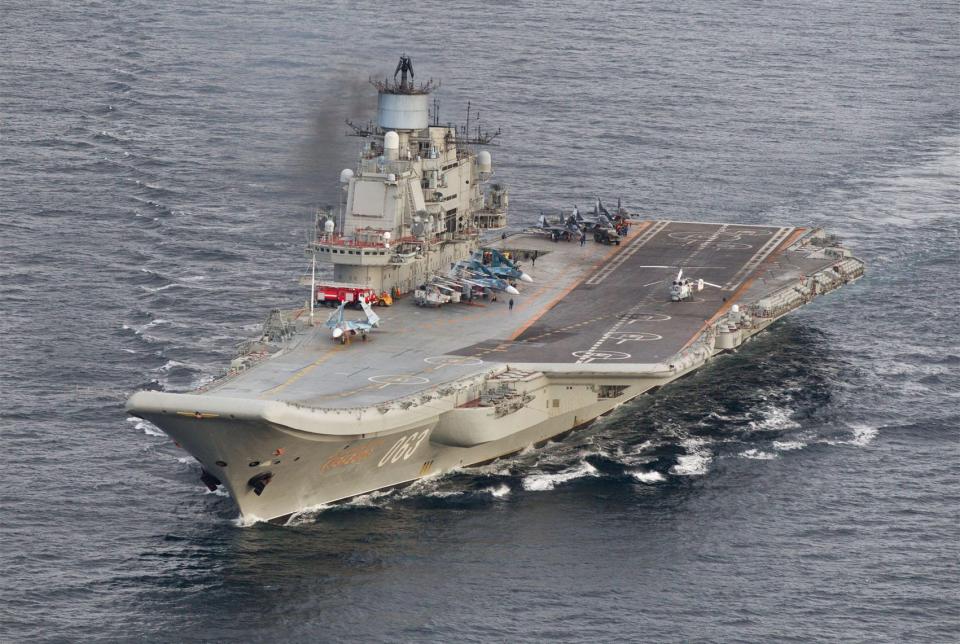
Admiral Kuznetsov is about 1,000 feet long and displaces about 58,000 tons — roughly as long but only half the displacement of the US's Nimitz-class carriers. The Kuznetsov's air wing is composed of 18 to 24 jets, mainly Su-33s and MiG-29Ks, and about a dozen Ka-27 or Ka-31 helicopters.
The Kuznetsov's main armament is 12 P-700 Granit missiles in launchers in the forward section of the flight deck, just before the ski-jump. It also has 190 3K95 Kinzhal surface-to-air missiles and 14 close-in weapons systems, six AK-630Ms and eight Kortiks, for air defense.
The missile arsenal allowed the Soviets to classify Kuznetsov as a "heavy aircraft-carrying cruiser" — an important distinction, as it meant the ship could legally transit the Turkish Straits, allowing it to exit the Black Sea, where it was built.
Mixed records
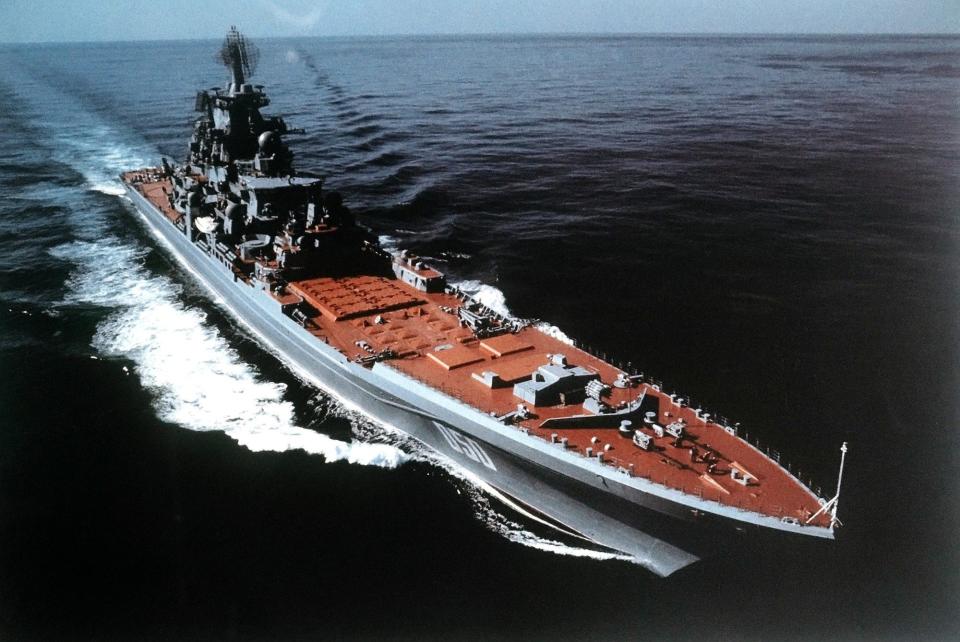
The Kirovs were imposing ships. After they entered service, the US Navy reactivated and modernized its four Iowa-class battleships to add muscle to its own fleet. As stout as they and the Kuznetsov were, however, they couldn't avoid the collapse of the Soviet Union.
During the 1990s, Moscow cut its defense budgets and the military's maintenance issues mounted. The Russians ultimately wrote off over 70% of the Soviet ships they inherited (many of which were outdated anyway).
The size and complexity of the Kirovs meant they needed constant, intense maintenance, which the Soviets and then Russians could scarcely afford.
Maintenance issues forced Kirov and Frunze out of operation in the 1990s. Russian officials decided in 2019 that repairing and modernizing them was too expensive, and both are now being scrapped.
Kalinin, renamed Admiral Nakhimov, rarely deployed after the Cold War. In 1997, it entered a shipyard in Severodvinsk and never left. In 2006, the Russians decided to give it an extensive overhaul and modernization, which began in earnest in 2014.

As the newest ship in the class, Pyotr Velikiy was the most modern. After repairs in 2004, it had a respectable service life, which included deployments around the world. It is currently the flagship of the powerful Northern Fleet.
Like the Kirovs, the Kuznetsov has been plagued by mechanical issues. It has been so breakdown-prone that an ocean-going tug sailed with it on deployments in case it needed to be towed back to Russia.
In 2016, the carrier sailed to Syria — belching thick black smoke along the way — for what is still its only combat mission. It didn't go well: Two jets crashed into the Mediterranean because of issues with the carrier's arresting cable, which eventually led Russia to transfer the entire air wing to a base in Syria.
After the Syria deployment, the Kuznetsov returned to port for an extensive refit. Even in port, the carrier has been unlucky. In 2018, its floating dry dock sank, causing a 70-ton crane to smash through the flight deck. Two fires, one of them deadly, have broken out on the ship since then.
Kuznetsov has been so troublesome that a Russian lawmaker recently proposed scrapping it and trying to acquire the Kuznetsov's sister ship, which Ukraine took possession of after the Soviet collapse and sold to Beijing as an incomplete hull in 1998. (China's navy finished and commissioned that vessel as its first aircraft carrier, Liaoning, in 2012.)
Modernization hopes
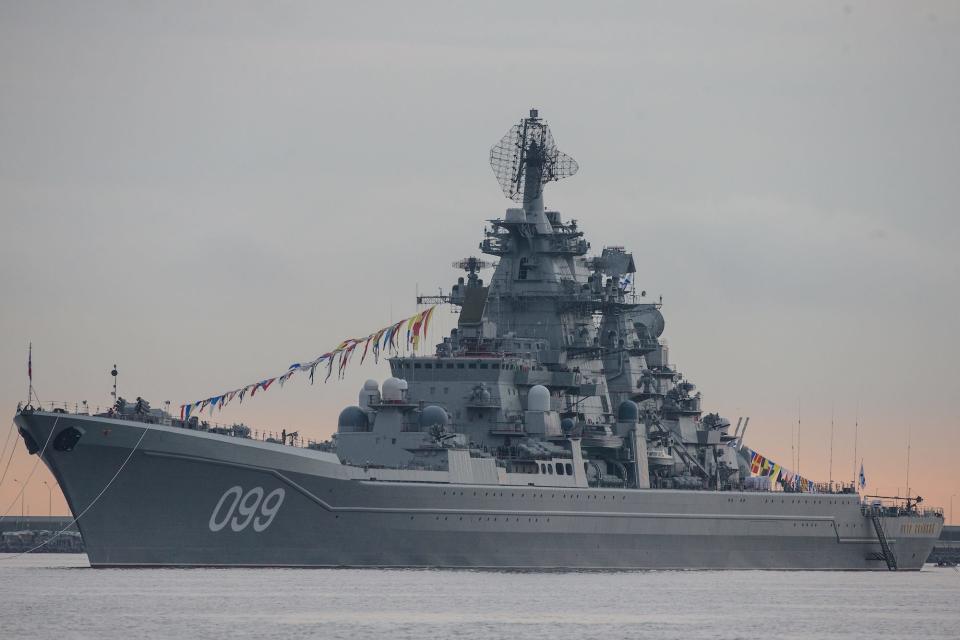
Despite the setbacks, Russia seems committed to bringing both Admiral Nakhimov and Kuznetsov back to its fleet.
Russian media has reported that Admiral Nakhimov's cable networks and radio-electronic systems have been replaced and that it now carries Kalibr and P-800 Oniks anti-ship missiles. It is also set to receive Otvet anti-submarine missiles, the Pantsir-M anti-air system, and the Paket-E/NK torpedo system.
Russian officials also plan to arm Nakhimov with the 3M22 Zircon hypersonic missile.
After work on the Admiral Nakhimov is completed, the Pyotr Velikiy is supposed to enter the same shipyard for similar upgrades. However, Russian state media, citing a navy source, reported in April that the battlecruiser may be retired instead because of the high costs of Admiral Nakhimov's refit. Other Russian navy sources quickly denied the report to another state media outlet.
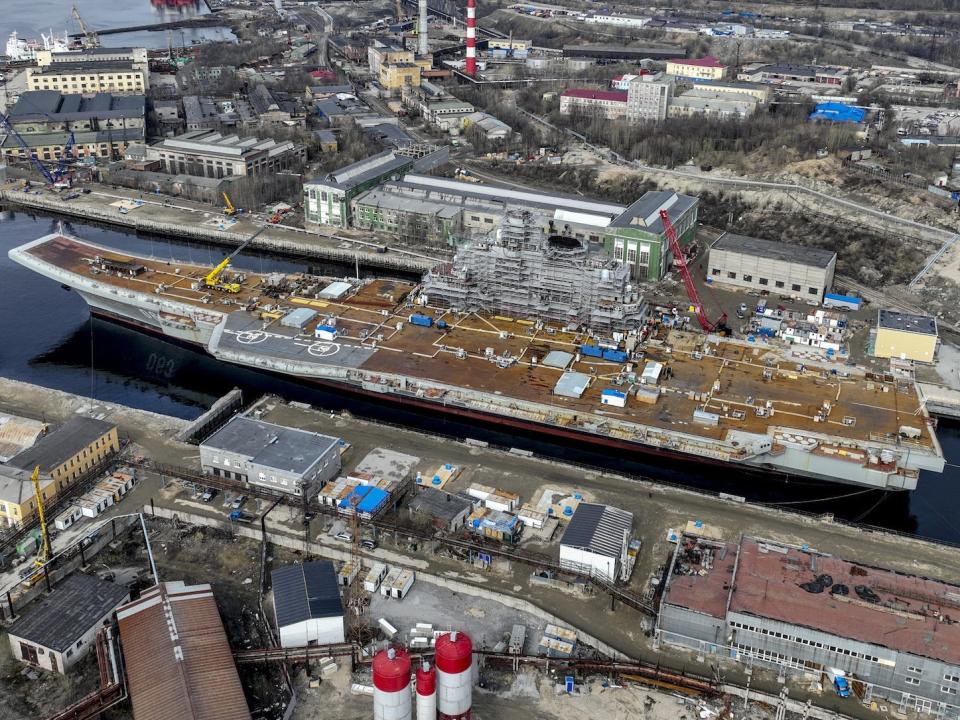
Kuznetsov was put in a new, specially built dry dock in May 2022. Russian outlet Izvestia has reported that the carrier's upgrades will include Pantsir-M air-defense systems, a new integrated air-defense control system, new boilers, and special storage facilities for new precision-guided munitions.
Izvestia has also reported that the Russian navy is reforming the Kuznetsov's crew, which was mostly disbanded when the ship began its refit.
Thanks to new automated systems, the crew is supposed to number about 1,500 sailors and aviators, down from 1,900, but Kuznetsov has neither set sail nor had a functioning air wing for about seven years, and the new crew will have to get familiar the ship and its new systems.
The shipyards doing the refits have said they intend to deliver both Admiral Nakhimov and Kuznetsov sometime next year. Delivery dates for both ships have already been pushed back several times, and if the war in Ukraine forces Moscow to reconsider its naval ambitions, they may never return.
Read the original article on Business Insider

